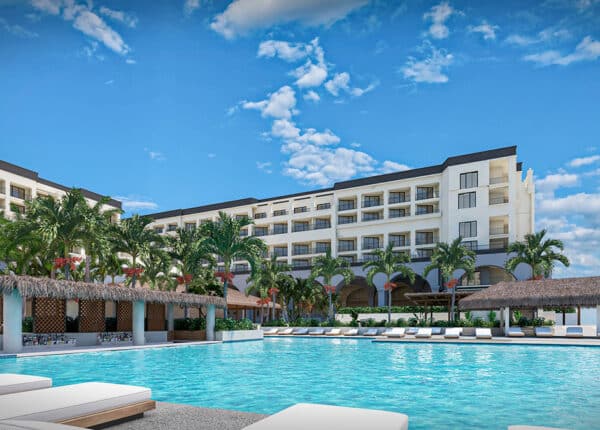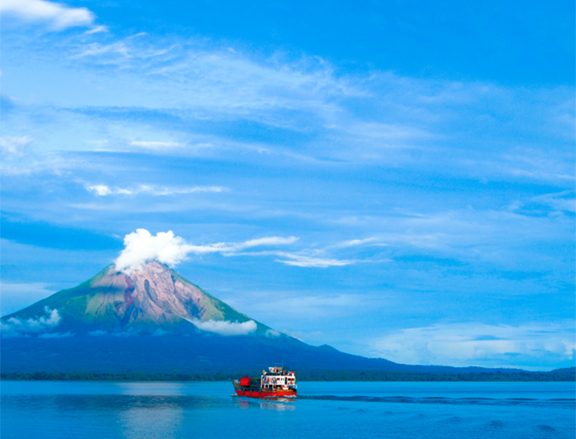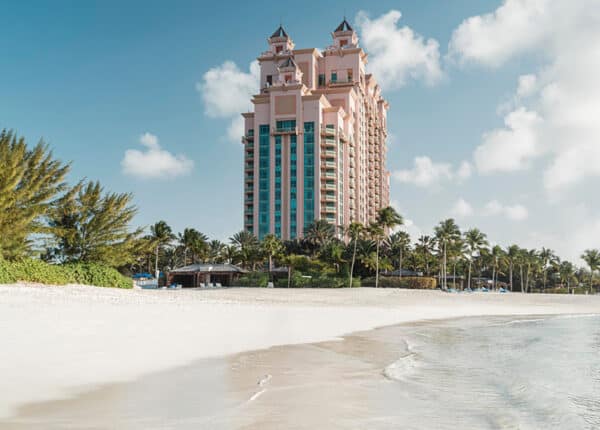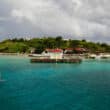Above: Lake NIcaragua
By George Nicholson and Rachael Robinson
Op-Ed Contributors
On Dec. 22, 2014, the Government of Nicaragua and the international infrastructure development firm, Hong Kong Nicaragua Canal Development Investment Co. Ltd. (HKND), publicly announced the commencement of the construction of the Interoceanic Grand Canal of Nicaragua.
Yet, this is not the first time that the idea of an interoceanic canal through Nicaragua has been conceived.
Nicaraguans have dreamt of building a canal for centuries, and the current proposal is the 72nd of its kind in 450 years.
In 1850, Great Britain and the United States of America both signed the Clayton-Bulwer Treaty in the hope of jointly building a canal through Nicaragua.
However, this did not come to pass due to intergovernmental disputes over the treaty’s content and the popular demand for the US to have unilateral control over any intended canal in Nicaragua. Later on in 1914, when construction of the Panama Canal was completed, the US cast its eyes once again on Nicaragua, gaining control of future national canal projects under the 1916 Bryan-Chamorro Treaty. Nevertheless, the treaty was annulled in 1970 as the US failed to exercise any of the rights granted to it under the convention. Today, plans for a Nicaragua canal have been revived.
The Interoceanic Grand Canal of Nicaragua is poised to be the world’s largest ever infrastructure project.
As proposed, it will be 278 km long and a maximum of 500 m wide, beginning at Punta Gorda in the Caribbean, transiting through Lake Nicaragua for 105 km to the mouth of the river Brito in the Pacific.
The developer has proposed that the new canal, which will be able to accommodate vessels up to 23,000 TEU, will complement rather than compete with the Panama Canal, which is in the midst of incorporating a third set of locks to accommodate 13,000 TEU vessels.
The new construction promises to improve shipping in the region, along with the expanded Panama Canal; Guyana’s potential deep-water port project in collaboration with Brazil; and major port expansion projects in Jamaica, the Dominican Republic and Colombia. The Grand Canal is expected to increase regional transhipment opportunities, stimulate foreign investment, and encourage further Caribbean maritime developments.
The region is already home to 100 ports and 167 maritime services, and is used by 69 shipping lines and 649 ships, carrying a total of 2,127,253 TEU annually.
With global trade projected to grow by an average of approximately 5% by 2030, trade relations between the Caribbean and the world are expected to evolve in the coming years. Asian investment in the region is advancing, with China pledging around US $2 billion toward Caribbean economic development and CARICOM projects in 2011, as well as providing approximately 2,500 training and study opportunities in China.
As reported by the Nicaraguan government, the Grand Canal project is expected to create significant employment opportunities and reduce national poverty by 50%.
Moreover, the future Grand Canal, together with the expanded Panama Canal, is expected to increase economies of scale for shipping within the Caribbean, thus intensifying maritime traffic at regional ports and potentially facilitating further port expansion.
There is, however, some scepticism regarding the economic viability of the $40 to $50 billion project.
The developer, HKND, projects that the 278 km-long canal would be completed within 5 years, whereas the Panama Canal, which is significantly shorter at only 77 km long, took 10 years and over twice its estimated budget to complete.
Moreover, a recent trade forecast report by British multinational banking company, Hong Kong Shanghai Banking Corporation (HSBC), shows that Latin America and the Caribbean represent the least promising region for trade over the coming months, casting aspersions on the project’s capacity to pay for itself through tariffs.
Nonetheless, HKND believes that the construction of the Canal will facilitate the region in becoming “one of the most important concentrations of shipping in the world” by 2030.
It has been posited that the Canal could increase Nicaragua’s annual economic growth by over 10% and is expected to transport 5% of the world’s maritime trade when canal operations begin.
Similarly, the economic impact of the Panama Canal, which is currently undergoing a US $5.2 billion expansion, has increased national GDP by 3.5% and created over 5000 jobs since the start of the project.
Furthermore, since its handover to the Government of Panama in 1999, the Canal contributions to the economy have exceeded US $10 billion, with the Panama Canal Authority (ACP) projecting that its annual transfers to the State may rise eightfold to over US $4 billion by 2025.
Additionally, the waterway would not only considerably expand China’s footprint in the western hemisphere, but is also expected to have a significant impact on global trade dynamics and in particular, global shipping.
The new canal is expected to directly compete with the Suez Canal in Egypt, which is currently the global leader in container capacity with the ability to accommodate post-Panamax vessels. Ten percent of the world’s trade, or 18,000 ships per year, pass through this 163 km waterway, which, on average, is only 60 m wide, and is one-way for most of its length, forcing ships to travel in convoys. While it can accommodate all ships other than the largest crude-oil tankers, the Suez Canal is currently considered to be a chokepoint for transport between Asia and Europe.
Plans have already been implemented to increase its capacity by building a bypass channel, effectively doubling its size at some locations. This will not only eliminate the need for convoys, which can cause delays, but will also double the daily capacity and reduce transit times through the canal from the current 18 hours to 11 hours. Notwithstanding the current delays through the Suez Canal, which can be up to 30-40 hours, many operators in the Asia-U.S. East Coast trade line have opted to use the Suez Canal to reduce losses as a direct result of increased marine tariffs elsewhere.
As global manufacturing bases move to South and Southeast Asia, with India’s manufacturing industry projected to generate US $1 trillion by 2025, more shipping lines are expected to utilise the Suez Canal to reach the U.S. East Coast; the world’s two largest container shipping lines, Maersk Line and Mediterranean Shipping Co, have already opted to transport all Asia-U.S. East Coast cargo via the Suez Canal in their operational alliance beginning this year.
However, this shift in transport routes must be considered in the context of trade between Asia and Latin America.
China’s trade with Latin America increased from $12 billion in 2000 to $250 billion in 2012 due to its high demand for mineral resources from South America. It is a major buyer of Venezuelan oil and gas and Brazilian iron ore, yet many of the cargo vessels carrying this iron ore are presently blocked from passing through the Panama Canal as they are too large for the lock system that lifts vessels above sea level.
Similarly, the large size of oil supertankers prevents them from passing through the canal. As Asia’s demand for resources is not expected to slow, opportunities therefore exist for improvements in trade and development of new markets. For instance, coal-fired power in Asia is expected to rise to 1,464,000 MW in 2020 up from 918,000 MW in 2013, with India accounting for 199,000 MW of this new demand over the next 10 years.
Coal from Colombia, which is the largest producer in South America, is highly sought-after due to its low cost and low sulphur content; yet the majority of Colombia’s coal exports are shipped to Europe rather than Asia, due to shorter distances and lower freight costs.
Consequently, the construction of the Nicaragua Canal would provide a new maritime route which would facilitate larger ships and thus stimulate this trade between Latin American and Asian countries.
With a new Nicaragua canal project now underway, major changes are heralded not only for Central America, but for the Caribbean sub-region.
Although there are other factors to consider such as the upgrading of a formidable rival canal in the Middle East, the project will certainly have a favourable impact on shipping in the region.
Benefits will accrue to shipping lines which will surely improve their bottom lines, given the efficiencies expected to arise from reduced shipping times and increased competition between global routes, coupled with the development of larger ships. What remains to be seen is how the Greater Caribbean positions itself accordingly to take advantage of these new opportunities. Thus, in order to fully profit from the impending construction of the Nicaragua Canal, regional governments must ensure that their respective maritime strategies are of the highest quality to safeguard economic interests.
George Nicholson is the Director of Disaster Risk Reduction and Transport, and Rachael Robinson is the Research Assistant Disaster Risk Reduction and Transport at the Association of Caribbean States.
Note: the opinions expressed in Caribbean Journal op-eds are those of the author and do not necessarily reflect the views of the Caribbean Journal.







